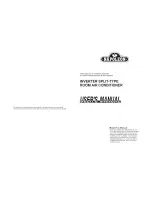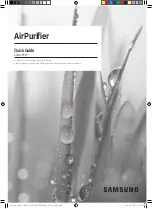
Due to our policy of continuous product innovation, some specifications may change without notification.
©LG Electronics U.S.A., Inc., Englewood Cliffs, NJ. All rights reserved. “LG” is a registered trademark of LG Corp.
71
Checklists
INSTALLATION CHECKLIST
Major Component Rough-In
Description
Check
Single Zone outdoor unit was connected properly per local code and the product installation procedures.
All literature and bagged accessories have been removed from the fan discharge.
Indoor unit was installed, properly supported, and located indoors in a non-corrosive environment.
Single Zone unit’s gravity condensate drain line was connected and routed where it properly drains away or, if installed in a
mechanical room, was connected and properly routed to a drain terminal.
Piping and Insulation
Description
Check
Single-zone and multi-zone duct-free split systems: ACR copper piping rated at the system working pressure for R410A was used.
All refrigerant pipes and valves were insulated separately. Insulation is positioned up against the walls of the indoor unit. No gaps
shown. Insulation was not compressed at clamps and hangers.
Brazing Practices
Description
Check
Medical grade (there are 4 available) dry nitrogen for purging during brazing was used (constant 3 psi while brazing).
15% silver brazing material only.
Refrigerant Piping
Description
Check
All pipe materials were properly stored, capped, and clean. All burrs were removed after cutting and pipe ends were reamed
before brazing.
During refrigerant pipe installation, for each segment of pipe, a record was made of the pipe length (including expansion loops,
offsets, double-back sections), and sizes, as well as the quantity and type of elbows used.
Expansion loops, coils or other acceptable measures are provided where necessary to absorb temperature-change based pipe
movement.
A torque wrench and backup wrench were used to tighten all flare connections.
The back side of all flares were lubricated with a small drop of PVE refrigeration oil before tightening flare fittings.
Ensure all field made flares are 45°. Use factory-supplied flare nuts only.
3LSHVHJPHQWVZHUHVHFXUHGWRWKHVWUXFWXUHXVLQJDFRPELQDWLRQRI¿[HGDQGÀRDWLQJFODPSVDQGDOOZDOOSHQHWUDWLRQVZHUHVOHHYHG
Pipe insulation was not compressed at any point.
No oil traps, solenoid valves, sight glasses, filter driers, or any other unauthorized refrigerant specialties were present.
(Optional) High quality R-410A rated full port ball valves (Schrader between the valve body and the indoor units) used at the
indoor unit and at will in the refrigerant piping.
Condensate Pump / Drain Installation
Description
Check
Condensate drain installed on indoor units. Extended condensate piping material used is acceptable under local code. Insulated to
prevent condensation.
Indoor unit condensate drain pipes were installed correctly.
Indoor unit with a gravity drain were level or slightly canted toward the drain connection and is supported properly.
Drain lines are properly insulated to prevent condensation.
Power Wire and Communication Cables
Description
Check
Power wiring to the Single Zone outdoor unit is solid or stranded, and complies with all local and national electrical codes.
Power wiring was connected to a single phase 208-230V source (Mega) or 115V source (Mega 115V).
Ground wire was installed and properly terminated at the unit.
The power supplied was clean with voltage fluctuations within specifications. (±10% of nameplate).
Power wiring to the Single Zone outdoor unit was installed per all local electrical code requirements.
• When the wiring length is up to 130 feet, communication / connection (power) wiring from the outdoor unit to the indoor unit is mini-
mum 14 gauge, four-conductor, stranded, shielded or unshielded. If shielded, must be grounded to chassis at the outdoor unit only.
• When the wiring length is GREATER THAN 130 feet, communication / connection (power) wiring from the outdoor unit to the indoor
unit is minimum 14 gauge, stranded, shielded or unshielded. If shielded, must be grounded to chassis at the outdoor unit only. Use
a two (2) conductor wire for power; use a two (2) conductor wire for communication / ground. Separate the power AT LEAST two (2)
inches away from the communication / ground wire.
Wiring to the indoor unit was installed per all local electrical code requirements.
Communication / connection (power) wiring from the outdoor unit to the indoor unit can be run in the same conduit.
Communication type RS-485–BUS type.
LG-supplied cable was used; or 22-3 AWG, twisted, stranded, unshielded cable (minimum) was used between the indoor unit and
its zone controller. No cables were spliced, and no wire caps are present.
Appropriate crimping tool was used to attach ring or spade terminals at all power wiring and control cable terminations.
Power and control wires were run in the same conduit (outdoor unit to indoor only) as provided in the product installation manual.
Power to outdoor unit and power/communications to indoor unit CANNOT be run in the same conduit.


































